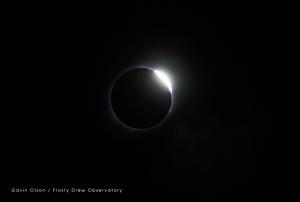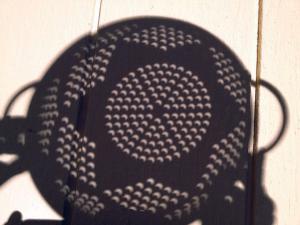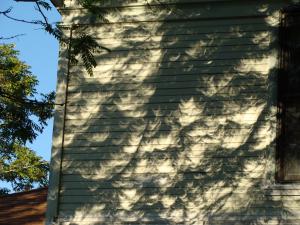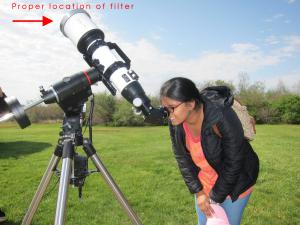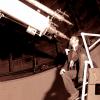The Great American Solar Eclipse
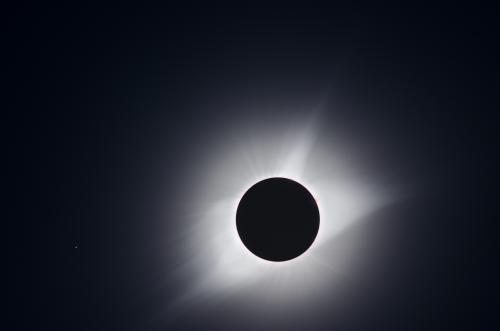
The corona is visible during the total eclipse stage. Image credit: Robert Horton of Brown University captured this image during the 2017 total solar eclipse.
This coming Monday, April 8, 2024 at 2:23 pm ET, the Moon will orbit into a position where it is between the Earth and the Sun. This is called the new Moon, and will bring the darkest night for the 29.5 day lunar synodic period. On April 8th, the Moon will rise and set with the Sun. Since the Moon is between the Earth and the Sun, the side of the Moon that gets direct sunlight is opposite the side that faces Earth. Usually, observing the new Moon is extremely difficult, as well as dangerous for your vision, due to its close angular proximity to the Sun. So we don’t often encourage a view, but this new Moon is special, because it will be highly visible across North America as a solar eclipse.
The Moon orbits Earth inclined 5.1º to the ecliptic, which is the path the Sun takes across the sky. Because of this, the Moon can be within 5.1º above or below the ecliptic during a new Moon. On Monday, April 8th, the Moon will be about 0.45º above the ecliptic, which places the Moon into the visible path of the Sun over North America. The problem with the timing of all of this awesomeness is that it’s happening in North American spring, which is notorious for clouds and rain. As for the prospect of cloudy sky conditions, we really do not even check until the day before. This is because forecasting sources are so unreliable in predicting, at times, the weather that is actually occurring.
At Frosty Drew, we will NOT be hosting an onsite event, and our facilities will be closed to the public for the eclipse. We know of a friend who will be set up in the Frosty Drew Observatory Courtyard and he will be using some of our solar viewing equipment. His name is Brian and he should be the only person with acceptable equipment. No one else should have equipment set up on the Frosty Drew campus, and if so, visitors should absolutely not observe through it because we cannot vouch for the safety of those devices. It should be noted that you will not need to be at an astronomical observatory to experience the eclipse. Anywhere the Sun is visible will be just as good. If you do not have any safe direct viewing devices, there are several indirect methods that you can use, that are often better at showing the eclipse.
Dig into your kitchen cabinets and grab that colander with the big holes. Go outside with a piece of cardboard or other large(ish) surface. Place the Sun to your right and hold the colander up so sunlight shines through the holes and projects the view onto the cardboard (or whatever surface you are using). Instead of round points of light, you will see little eclipses! Whatever you do, tonight look directly at the Sun through the colander!
Have some cardstock laying around? Well grab two pieces and a hole punch. Punch a hole (or several holes all spaced out) in one of the pieces. Stand with the Sun to your right and hold up both pieces, one in each hand. Orientate the piece with holes about 12” over the piece without. Look at the bottom piece and you will see eclipses projected onto it. Whatever you do, tonight look directly at the Sun through the hole!
Even though it is too early for leaves to come out. You can sit under a pine tree or other shade tree and look at the ground. There will be hundreds of little eclipses all over the ground. This is my favorite way to observe an eclipse!
If you are feeling bold, and are safety conscious, you can set up a solar projector using either a small birding telescope, or binoculars. DO NOT LOOK THROUGH THEM AT THE SUN! What you do instead is stand near a wall with the Sun behind you, and hold up the binoculars or telescope so that the Sun shines through them and projects onto the wall. Under no circumstance should you even consider looking through them, unless you want to permanently lose your vision!
There is tons of misinformation and nonsense out there about how to observe an eclipse. Do not look at a reflection of the Sun. Do not hold your phone up to the Sun without a filter. Do not stack sunglasses to look directly at the Sun. Do not use a DVDR or CDR to look at the Sun. The only devices that are safe for direct visual observation of the Sun are Eclipse Glasses that pass the tests listed in our newsletter from last Friday, or Shade 14 Welder’s Glass. For binoculars and telescopes a White Light filter will be required that is attached at the aperture end of the device. DO NOT just walk up to a person with a telescope pointed at the Sun and look through it. Start by asking questions:
1: What type of filter do you have?
If the answer is “white light filter”, then the next question should be:
2: Where is the filter located?
The only correct answer is on the front or on the top side of the telescope that is pointed at the Sun. Any other placement is NOT okay!.
If the answer to question 1 is “hydrogen alpha” then the next question should be:
2: Is the telescope a hydrogen alpha telescope, or do you just have a hydrogen alpha filter?
The answer needs to be “hydrogen alpha telescope”. A hydrogen alpha filter is NOT adequate.
Taking a few minutes to ask about the equipment could make the difference between developing a lasting memory of the eclipse vs a lasting vision impairment. If the person you are asking becomes frustrated, that is an easy indicator to just walk away.
Frosty Drew Observatory will be live streaming the eclipse from several locations along the path of total eclipse. Our live stream will be a passive live stream, meaning that we will not be offering constant commentary, which could become annoying when you just want to see the eclipse. We will have our cameras tracking the Sun, and will offer periodic commentary on what we are seeing. Tune into the Frosty Drew live stream which will go live at 1:00 pm ET. If you have a cloudy sky, are outside of the region with the eclipse, or just can’t make it outside, then tune in and enjoy a live view of the total solar eclipse.
We hope you all have a fantastic day with the eclipse!
- Author:
- Scott MacNeill
- Entry Date:
- Apr 5, 2024
- Published Under:
- Scott MacNeill's Columns

